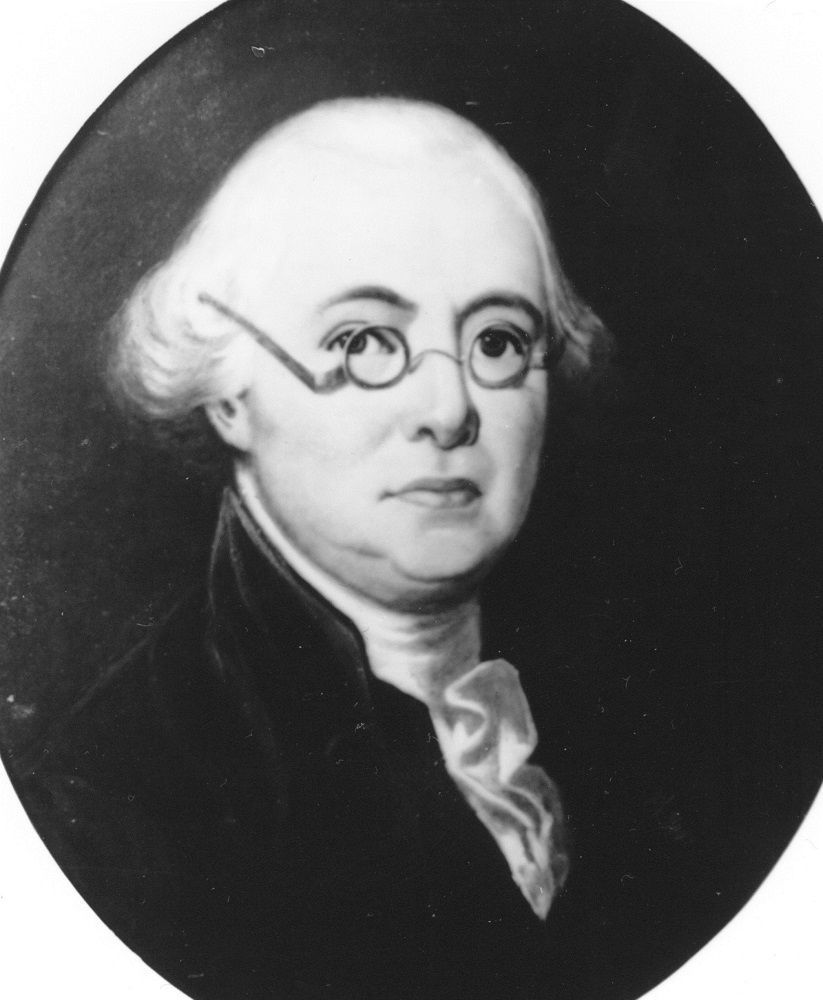Brigadier-General William Thompson
In Carlisle’s Old Graveyard at the corner of East South and South Bedford Streets is located an eight foot Celtic cross commemorating the burial place of Brigadier-General William Thompson.

James Wilson, signer of the Declaration of Independence (00289C).
The provincial town of Carlisle was fortunate to have among its mist for a short period a political theorist and talented lawyer, James Wilson. Born in 1742 at Carskerdo near St. Andrews, Scotland, Wilson studied at St. Andrews, Glasgow and Edinburgh. Emigrating to America in1765, he first took a tutoring job at the College of Philadelphia.1 Next Wilson studied law under John Dickinson and was admitted to the Philadelphia bar in 1768. He established a law practice in Reading and two years later moved to Carlisle purchasing a house on the north-west corner of West High and South Pitt Streets.2
The rebellious spirit had slowly permeated Pennsylvania and especially Cumberland County with its strong Scots-Irish population. Wilson involved himself in its politics by becoming chairman of Carlisle’s committee of correspondence and attended the first provincial assembly in 1774. Also, he wrote a tract that was read widely in the colonies and England entitled “Considerations on the Nature and Extent of the Legislative Authority of the British Government”. The paper set down a number of arguments which severely challenged parliamentary authority over America. Wilson stated that he could accept some powers of the Monarch but would not subject himself to the whims of Parliament in which the colonies had no representation.3 In 1775, James Wilson signed the Declaration of Independence as a member of the Second Continental Congress. He preferred to take a slow approach to independence but the Pennsylvania delegation was deadlocked and he did not want to perpetuate the situation.
Beside serving in the Continental Congress, Wilson was also a member of the Pennsylvania Provincial Assembly and was a strong opponent of the republican Pennsylvania constitution of 1776, he led a fourteen year fight against its adoption.4 This culminated in a confrontation in the fall of 1779 during a period of inflation and food shortages when a mob attacked his Philadelphia residence located at Third and Walnut Streets. Some thirty-five of his colleagues barricaded themselves in his home and fought off the attack. General William Thompson of Carlisle was also serving in the Pennsylvania Assembly at the time and came to Wilson’s aid.5
In 1781, Wilson was appointed as one of the directors of the Bank of North America, newly founded by Robert Morris. Within the next six years Wilson had a great deal of influence at the Constitutional Convention, he sat on the Committee of Detail and rarely missed a session. He had excellent knowledge of political theory and applied this knowledge to many of the conventions problems.6 When the federal government was formed in 1789, Washington appointed him as an associate justice to the Supreme Court. During the appointment Wilson wrote few opinions and did not excel as in the past. One of his weaknesses was that of land speculating. He made unwise land purchases in Western New York, Pennsylvania, and Georgia that depreciated in value and spent several years traveling extensively trying to avoid creditors. After suffering much mental stress he was rescued by fellow Supreme Court justice James Iredell and taken to the latter’s home where he died. Wilson was buried in the Johnston cemetery at the Hayes plantation located near Edenton, North Carolina. In 1906, his remains were reinterred in the burying grounds of Christ Episcopal Church, Philadelphia, Pennsylvania.7
In Carlisle’s Old Graveyard at the corner of East South and South Bedford Streets is located an eight foot Celtic cross commemorating the burial place of Brigadier-General William Thompson.
1 Dumas Malone, editor, Dictionary of American Biography, (New York: Charles Scribner’s Son, 1936) volume 30, p.327
2 Merri Lou Scribner Schaumann, A History & Genealogy of Carlisle, Cumberland County, Pennsylvania: 1751-1836, (Carlisle: 1985) p. 37
3 Ibid., Malone, p328
4 Conway P. Wing, D.D, History of Cumberland County, Pennsylvania, (Philadelphia, James D. Scott, 1879) p. 78
5 Craig W. Horle, editor, Lawmaking and Legislators in Pennsylvania: A Biographical Dictionary 1757-1775, (Harrisburg, Commonwealth of Pennsylvania, House of Representatives, 2005) volume 3:2, p 1365
6 Ibid., Wing, p107
7 James Perry, editor, The Documentary History of the Supreme Court of the United States, 1789-90, (New York: Columbia University Press, 1985) volume I, p.63